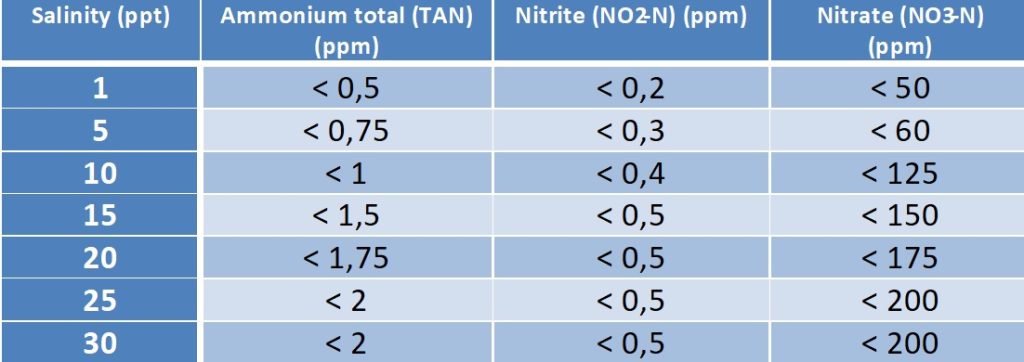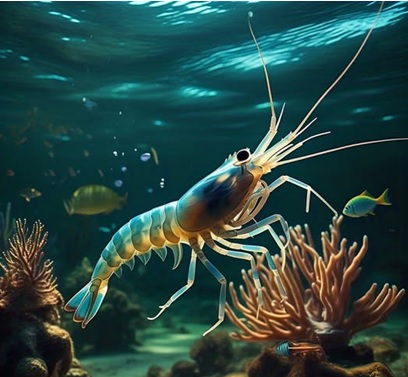VANNAMEI SHRIMP AQUACULTURE AND WATER QUALITY MANAGEMENT (Part 2)
By: Jaime Ulises Paz Lopez
4. Safe nitrite levels and influence of salinity
Generally speaking, it is considered that the safe concentration of nitrite-N in Vannamei shrimp aquaculture should not exceed 0.5 ppm. Some sources even recommend keeping it below 0.1 ppm, reflecting the high toxicity of this compound.
As with ammonia, salinity has a significant influence on nitrite toxicity in Vannamei shrimp. In general, a decrease in salinity leads to an increase in nitrite toxicity for most shrimp species, including Vannamei. Nitrite uptake by shrimp increases in hypoosmotic environments due to competition with chloride ions in the gills. The acute toxicity of nitrite increases with exposure time. Studies have shown that nitrite is more toxic than ammonia and nitrate in waters with low salinity. For young L. vannamei, the 96-h LC50 for nitrite-N was higher at salinities of 15, 25 and 35 g/L compared with low salinities (0.6-3.0 g/L). Safe concentrations of nitrite-N were found at very low salinities (0.6, 1.0 and 2.0 g/L) of 0.28, 0.35 and 0.62 mg/L, respectively. A study conducted at a salinity of 2 g/L suggested a safe nitrite-N concentration of less than 0.45 mg/L. A small change in salinity from 2.0 to 0.6 g/L is more critical for nitrite toxicity than larger differences in brackish and marine waters (15-35 g/L). These data highlight that nitrite toxicity is particularly pronounced in low salinity environments, requiring very careful monitoring and management. Even small fluctuations in very low salinities can have a significant impact on nitrite toxicity.
Based on available information, the following recommended ranges for nitrite at specified salinity levels can be proposed:
- 1 ppt: Keep nitrite-N below 0.2 ppm.
- 5 ppt: The target should be nitrite-N below 0.3 ppm.
- 10 ppt: A nitrite-N concentration of less than 0.4 ppm is recommended.
- 15 ppt: Keep nitrite-N below 0.5 ppm.
- 20 ppt: The target should be nitrite-N below 0.5 ppm.
- 25 ppt: Nitrite-N below 0.5 ppm is recommended.
- 30 ppt: Keep nitrite-N below 0.5 ppm.
These ranges reflect the increased sensitivity to nitrite in low salinity conditions and the need to maintain low levels across all salinity ranges to ensure shrimp health.
5. Safe nitrate levels and the influence of salinity
Of the three nitrogen compounds, nitrate is generally considered to be the least toxic. However, high concentrations can be harmful, particularly in low salinity conditions. Although its acute toxicity is minor, nitrate accumulation should not be ignored, particularly in systems with limited water exchange.
Nitrate toxicity appears to be more of a problem for shrimp reared in low salinity waters. Studies at salinities of 5 and 10 g/L revealed nitrate (N-NO₃-) levels recommended as safe of 60.05 mg/L and 127.61 mg/L respectively. In biofloc systems at a salinity of 23 ppt, nitrate concentrations of up to 177 mg/L were acceptable for rearing L. vannamei without water replenishment. Histopathological damage was observed at concentrations ≥ 300 mg NO₃–N/L at this salinity. These results suggest that nitrate tolerance tends to increase with salinity, although Vannamei shrimp can tolerate relatively high levels compared to ammonia and nitrite, especially under higher salinity conditions. Biofloc systems can exhibit different dynamics due to the presence of microbial communities.
Based on available information, the following recommended ranges for nitrate at the specified salinity levels can be proposed:
- 1 ppt: Keep nitrate-N below 50 mg/L.
- 5 ppt: The target should be nitrate-N below 60 mg/L.
- 10 ppt: A nitrate-N level of less than 125 mg/L is recommended.
- 15 ppt: Keep nitrate-N below 150 mg/L.
- 20 ppt: The target should be nitrate-N levels below 175 mg/L.
- 25 ppt: Nitrate-N below 200 mg/L is recommended.
- 30 ppt: Keep nitrate-N below 200 mg/L.
These ranges suggest an increasing tolerance to nitrate as salinity increases, although caution should be exercised in very low salinity conditions.
6. Water quality management in low salinity Vannamei shrimp aquaculture (1-10 ppt)
Low salinity (1-10 ppt) aquaculture systems present particular challenges compared to higher salinity systems. One of the main challenges is the increased toxicity of ammonia and nitrite under these conditions. In addition, there is a risk of ionic imbalance, which can affect the physiological processes of the shrimp. Lower survival rates have been observed at very low salinities (< 1 ppt), and acclimatisation to these levels may require careful management and more than 7 days. Low salinity aquaculture therefore requires adapted management strategies, particularly with regard to nitrogenous waste.
To effectively manage water quality in low salinity systems, the following strategies are recommended:
* Strict ammonia and nitrite monitoring: Test frequently (daily or even more frequently) for total ammonia (TAN) and nitrite-N.
* Lower planting densities: Reduce the total waste load on the system.
* Careful feed management: avoid overfeeding to minimise the input of organic matter that contributes to nitrogenous waste.
* Increased aeration: to promote nitrification and maintain adequate levels of dissolved oxygen, which can reduce shrimp stress in the presence of toxins.
* Water exchange: Performing partial water exchanges on a regular basis can help eliminate accumulated nitrogen compounds. The exchange volume may need to be higher in low salinity systems if ammonia or nitrite levels increase.
* Bio-augmentation: Use beneficial bacteria (probiotics) to enhance nitrification and break down organic matter.
* pH management: Maintain an optimum pH (7.5-8.5) as this considerably affects the toxicity of ammonia. Lime can be used to raise the pH if it is too low.
* Maintaining the Na:K ratio: In very low salinity systems, maintaining the correct balance of essential ions such as sodium and potassium can be crucial to shrimp health and stress tolerance.
* Progressive acclimatisation: Ensure that postlarvae acclimatise progressively to the low salinity target to minimise stress and mortality.
A multi-dimensional approach combining prevention, monitoring and intervention is required for successful low-salinity shrimp farming. As shrimp are already physiologically stressed under these conditions, any additional stressors, such as high levels of nitrogen waste, can have a more severe impact.
7. Integrated table of recommended safe concentrations
The following table summarises the recommended safe concentration ranges for total ammonium (TAN), nitrite (NO₂-N) and nitrate (NO₃-N) for Vannamei shrimp culture at the specified salinity levels. Concentrations are expressed in parts per million (ppm) or milligrams per litre (mg/L).

It is important to remember that these values are general guidelines and may need to be adjusted according to the specific conditions of the culture system and the life stage of the shrimp.
8. Conclusion and practical recommendations
In summary, management of ammonia, nitrite and nitrate levels is critical to the success of Vannamei shrimp aquaculture, and water salinity plays a crucial role in the toxicity of these compounds. In general, ammonia and nitrite toxicity tend to increase as salinity decreases, while nitrate tolerance can be lower under low salinity conditions.
For shrimp farmers, it is strongly recommended to:
- Regularly monitor water quality parameters including total ammonia, nitrite, nitrate, pH, temperature and salinity.
- Maintain salinity within the optimum range of 15 to 30 ppt wherever possible.
- Implement best management practices for feed, storage density and aeration to minimise the build-up of nitrogenous waste.
- Pay particular attention to water quality management in low salinity systems (1 to 10 ppt) due to the increased toxicity of ammonia and nitrite.
- Take into account the life stage of the shrimp, as larvae and postlarvae may have different sensitivities to nitrogen compounds.
- Consult the scientific literature and local aquaculture extension services for specific advice tailored to the conditions on your farm.
Although this article provides an overview of recommended safe concentrations, further research is required to fully understand the long-term effects of nitrate at different salinities and the interactive effects of multiple stressors in aquaculture systems.

